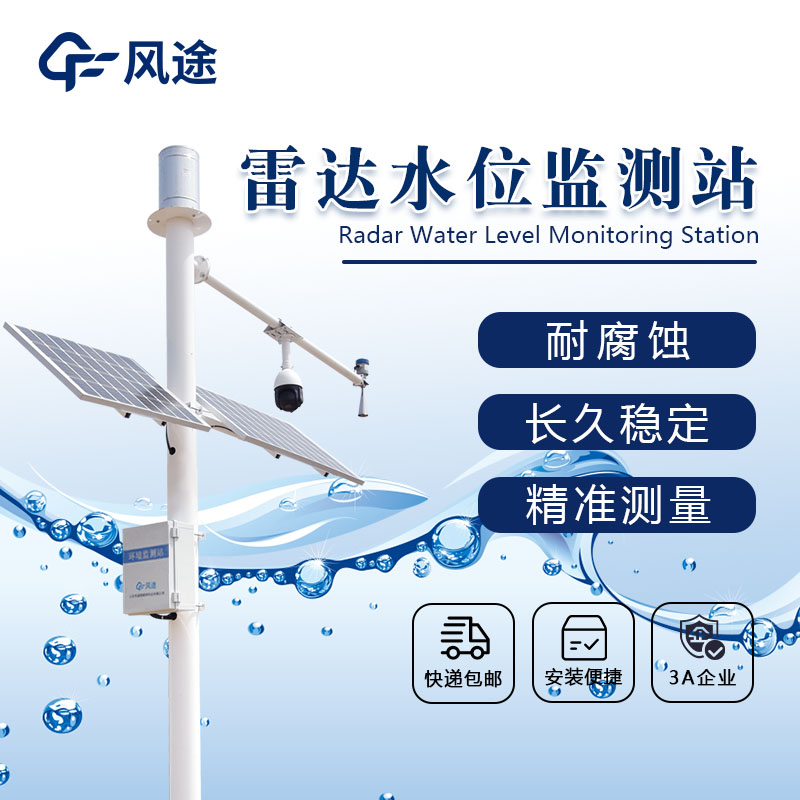Shandong Fengtu IOT Technology Co., Ltd
Sales Manager:Ms. Emily Wang
Cel,Whatsapp,Wechat:+86 15898932201
Email:info@fengtutec.com
Add:No. 155 Optoelectronic Industry Accelerator, Gaoxin District, Weifang, Shandong, China

Sales Manager:Ms. Emily Wang
Cel,Whatsapp,Wechat:+86 15898932201
Email:info@fengtutec.com
Add:No. 155 Optoelectronic Industry Accelerator, Gaoxin District, Weifang, Shandong, China
time:2025-06-06 09:14:46 source:Weather Station viewed:377 time
Float-type and pressure-type sensors are prone to being affected by water flow scouring, sediment deposition, water quality corrosion, and floating debris impacts, leading to reduced measurement accuracy, equipment damage, and difficulty in stable operation under severe weather conditions. However, the "non-contact" Water Level Monitoring Station based on radar technology is different.
It adopts K-band (26GHz) planar radar technology. During operation, the radar water level sensor antenna emits radar pulses, which are reflected back from the water surface and received by the antenna, with the time (T) recorded. Since the propagation speed of electromagnetic waves (C) is constant, the distance to the water surface (D) can be calculated using the formula: D = C×T/2. The system performs 55 measurements per second, and through digital filtering processing, it converts nanosecond-level time measurements into millisecond-level data, significantly reducing the impact of water waves on measurement results. The measurement results are nearly equivalent to those of still water level measurements.
With high measurement accuracy reaching the millimeter level and a measurement range of up to 30 meters, its horn antenna design reduces power consumption, and it has a wide input voltage range, making it specially suitable for automatic stations in unmanned field applications. The measurement process is unaffected by factors such as atmospheric temperature, pressure, air density, wind, precipitation, and relative humidity, ensuring extremely strong stability.
In conventional water level monitoring scenarios such as lakes, rivers, reservoirs, open channels, wetlands, and tidal water levels, it stably provides accurate data. In areas with easily changing water quality, its non-contact feature avoids equipment corrosion caused by water quality. In ditches with abundant floating debris and sediments, as well as places with heavy aquatic plant growth, it does not suffer from reduced measurement accuracy due to debris interference. In solar-powered, remote field locations, and mountain flood-prone areas, its low-power consumption and high-stability characteristics make it an ideal choice.
It can also collect water level and rainfall data, featuring real-time clocks, timed storage, parameter setting, and power-off protection for historical parameter data. Equipped with standard RS232/485 communication functions and supporting the MODBUS communication protocol, it can form monitoring systems with computers through various communication methods, including wired connections, mobile wireless GPRS, and wireless data transmission radios. Capable of real-time monitoring and early warning, it automatically triggers an early warning mechanism when water levels are abnormal, sending warning messages to relevant personnel through multiple channels. It can also automatically record and store monitoring data, supporting historical data query and analysis to provide a scientific basis for water resource management decisions.

A UAV-specific visibility meter is a device specifically designed to measure and monitor visibility in the atmosphere, with the aim of providing accurate visibility information to assist UAV operators in flight decision-making and flight safety management. Visibility is the distance at which the hum...
Icing on transmission lines can lead to numerous serious consequences, threatening the safety of the power system and the efficiency of power transmission. The thickening of ice layers will cause excessive load on conductors, resulting in sagging and breakage, which may lead to circuit breaks; trans...
water quality sensor is used to measure common water treatment parameters, such as dissolved oxygen, conductivity, turbidity, pH, temperature, ammonium, nitrate, chloride, etc....
temperature and humidity monitoring Monitor the relative humidity and temperature of indoor or outdoor air to provide accurate data for various applications....